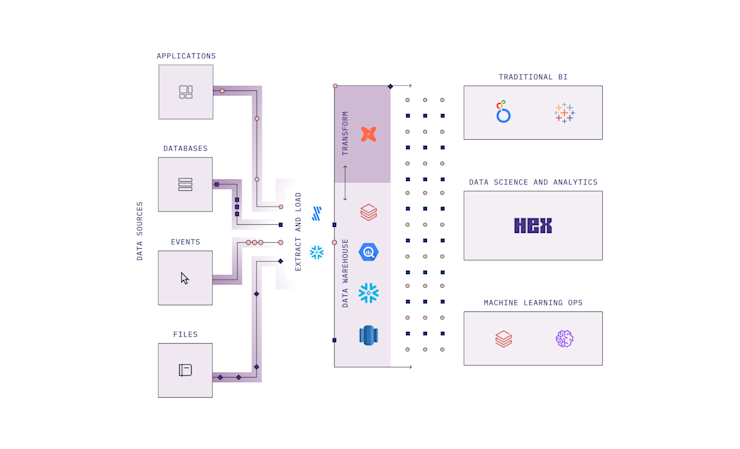Blog
Bringing data notebooks into the cloud era
Query mode, Chained SQL, and Python pushdown for everyone
We’re living in an era of infinitely-scalable cloud data infrastructure, but computational notebooks — a mainstay of data science workflows — haven’t caught up. The in-memory kernel model limits the amount of data you can work with, and the ephemeral, disorganized nature of notebooks holds data teams back from doing their core job: asking and answering questions.
We built Hex, however, to be cloud-native, and today we’re introducing three new features that allow you to work with data at any scale: Query mode, Chained SQL, and Python pushdown.
∞ Query mode
First, we’re launching Query mode for SQL cells, which lets you work with effectively infinitely-sized data — no more worrying about memory overhead or limits.
In Query mode, Hex leaves the data in the warehouse instead of bringing it into the in-memory kernel. It’s not just a limit preview though: like all cells in Hex, Query mode cells still return an object (in this case, a Query, in lovely purple). A Query object can be used downstream in other cells, and is represented in the DAG, but is just a pointer to the full result set.
When it’s time to build visualizations, or run in-memory operations over the full dataset, you can easily flip the SQL cell back into Dataframe mode (which is the original, and still default, behavior).
🕵️♀️ Real world example: you're working with a new dataset that has 200M rows. You want to explore it iteratively and aggregate it down as you go, but it's too big to even get started with. Query mode will let you keep results in the warehouse until they're small enough to work with in-memory, while still manipulating and iterating on the data.
⛓ Chained SQL
Next, we’re introducing the ability to reference previous queries with other SQL cells, and Hex will automatically combine the queries into common table expressions (CTEs) on the fly. 1
To use this, just reference any SQL cell result (a Query or Dataframe) in a downstream query using the same data connection. In the background, Hex will build the with...as statements for you, and you can see the fully-compiled query right there in the cell:
These “Chained SQL” queries work great with Query mode, allowing you to do multiple-step operations without pulling each intermediate result into memory. Then, at the end, you can flip the last cell into Dataframe mode and have a result set ready to use.
Chained SQL is complementary to Dataframe SQL, which lets you query any dataframe, including other query results, Pandas dfs, or even CSVs. And of course, all of this works great with Hex’s existing first-class SQL support, including a schema browser, typeahead, dbt Docs, Jinja, and auto-formatting.
🕵️♀️ Real world example: you're writing a giant SQL query with 10 CTEs, and all those WITHs and parentheses are getting tough to follow. The query starts erroring, but you're not sure which CTE is causing it. Breaking this up into 10 distinct chained SQL queries, it's easy to see which SQL cell is erroring and debug it individually from the rest.
🐍 Pushing Python to Snowpark
That’s all great for SQL, but what about Python? Well, that’s becoming cloud-native too.
Last week, we introduced support for Snowpark, allowing you to run Python code right in Snowflake. Think of this like Query mode, for Python: Hex is running the operation in the warehouse, working with the data where it lives instead of shuttling it back and forth to an in-memory kernel.
In Hex, this support is truly first class – any existing Snowflake data source can turn on Snowpark, and then with one click create a connection in a project.
For many use cases, Snowpark is far more efficient and performant than shuttling data over the internet and executing the code in a kernel.
🕵️♀️ Real world example: you're running a model training step in Python over a large dataframe from Snowflake. With Snowpark, you can push that Python operation down, and run the compute in the same place as the data, netting better performance and less data transfer.
📈 Bonus: infinite-scale charts
Historically Hex, like many visualization products, had limits to the number of points that could be rendered in charts, because web browsers tend to fail when you try and render too much data.
Today, we're upgrading our charts to use server-side acceleration and aggregation, so they can handle data at any scale. 3 You can pass a dataframe of any size into a chart cell and aggregate it for display right from the chart configuration. Here's an example using a 900k row dataset:
⏩ Notebooks, meet the modern data stack
“Modern data stack” can be an ill-defined buzzphrase, but to me the simplest definition is “a set of tools that assume modern data warehouses”, and the most profound consequence of this is the ability to work with much larger scale data than was previously possible.

With these new features in Hex, we’re bringing notebook workflows to the Modern Data Stack™, and enabling data practitioners to ask and answer questions of all of their data.
↩ Some of you might think of this like a “predicate pushdown”
↩ Under the hood, we're using VegaFusion to power this!